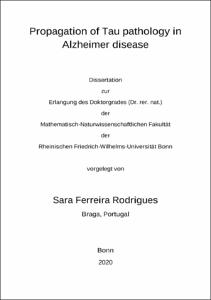Ferreira Rodrigues, Sara: Propagation of Tau pathology in Alzheimer disease. - Bonn, 2020. - Dissertation, Rheinische Friedrich-Wilhelms-Universität Bonn.
Online-Ausgabe in bonndoc: https://nbn-resolving.org/urn:nbn:de:hbz:5-58814
Online-Ausgabe in bonndoc: https://nbn-resolving.org/urn:nbn:de:hbz:5-58814
@phdthesis{handle:20.500.11811/8588,
urn: https://nbn-resolving.org/urn:nbn:de:hbz:5-58814,
author = {{Sara Ferreira Rodrigues}},
title = {Propagation of Tau pathology in Alzheimer disease},
school = {Rheinische Friedrich-Wilhelms-Universität Bonn},
year = 2020,
month = sep,
note = {Clinical and experimental evidences suggest that the spreading of tau protein throughout the brain may underlie the stereotypical progression of pathology in the brains of Alzheimer disease (AD) patients and concomitant cognitive decline. Although previous studies showed that tau protein can be released and taken up by cells, several open questions regarding the spreading of tau pathology still exist. The nature of the tau species that are able to spread across cells is still unknown. Furthermore, it is still debatable if the tau species that propagate across cells are the species responsible for the pathological changes. Recently, the involvement of other processes in the pathological mechanisms of AD, like neuroinflammation, further contributed to this debate. Therefore, this doctoral thesis monitored the potential involvement of the aggregation propensity of tau on the spreading of the protein across cells, and in the extent of pathology developed. This was achieved by using transgenic mouse models expressing mutant human tau (htau) with a pro-aggregant (ΔK280) or anti-aggregant (ΔK280-2P) mutation, restricted to the entorhinal cortex (EC). This study showed that the propagation of tau is independent of the protein’s aggregation potential, as both pro- and anti-aggregant htau propagate from the EC to other brain regions. In contrary, markers of tau pathology (phosphorylation, pathological conformation) did not spread further than the EC axon terminals located in the middle molecular layer of the dentate gyrus (DG). We also observed marked astrogliosis in the hippocampal region of mice expressing pro-aggregant htau, suggesting that neuroinflammatory processes may precede the spreading of tau pathology from the EC to the hippocampus.
Based on the principle that inhibiting tau aggregation may be a promising therapeutic target, we additionally tested the efficacy of BSc3094, a tau aggregation inhibitor, in reducing tau pathology using transgenic mice expressing mutant human P301L tau. BSc3094 reduced the levels of tau phosphorylation and insoluble tau, and improved cognition in some behavioral tasks as well.
Altogether, these results provide novel evidence about the mechanisms underlying the propagation of tau pathology, and highlight BSc3094 as a promising compound for a future therapeutic approach for AD.},
url = {https://hdl.handle.net/20.500.11811/8588}
}
urn: https://nbn-resolving.org/urn:nbn:de:hbz:5-58814,
author = {{Sara Ferreira Rodrigues}},
title = {Propagation of Tau pathology in Alzheimer disease},
school = {Rheinische Friedrich-Wilhelms-Universität Bonn},
year = 2020,
month = sep,
note = {Clinical and experimental evidences suggest that the spreading of tau protein throughout the brain may underlie the stereotypical progression of pathology in the brains of Alzheimer disease (AD) patients and concomitant cognitive decline. Although previous studies showed that tau protein can be released and taken up by cells, several open questions regarding the spreading of tau pathology still exist. The nature of the tau species that are able to spread across cells is still unknown. Furthermore, it is still debatable if the tau species that propagate across cells are the species responsible for the pathological changes. Recently, the involvement of other processes in the pathological mechanisms of AD, like neuroinflammation, further contributed to this debate. Therefore, this doctoral thesis monitored the potential involvement of the aggregation propensity of tau on the spreading of the protein across cells, and in the extent of pathology developed. This was achieved by using transgenic mouse models expressing mutant human tau (htau) with a pro-aggregant (ΔK280) or anti-aggregant (ΔK280-2P) mutation, restricted to the entorhinal cortex (EC). This study showed that the propagation of tau is independent of the protein’s aggregation potential, as both pro- and anti-aggregant htau propagate from the EC to other brain regions. In contrary, markers of tau pathology (phosphorylation, pathological conformation) did not spread further than the EC axon terminals located in the middle molecular layer of the dentate gyrus (DG). We also observed marked astrogliosis in the hippocampal region of mice expressing pro-aggregant htau, suggesting that neuroinflammatory processes may precede the spreading of tau pathology from the EC to the hippocampus.
Based on the principle that inhibiting tau aggregation may be a promising therapeutic target, we additionally tested the efficacy of BSc3094, a tau aggregation inhibitor, in reducing tau pathology using transgenic mice expressing mutant human P301L tau. BSc3094 reduced the levels of tau phosphorylation and insoluble tau, and improved cognition in some behavioral tasks as well.
Altogether, these results provide novel evidence about the mechanisms underlying the propagation of tau pathology, and highlight BSc3094 as a promising compound for a future therapeutic approach for AD.},
url = {https://hdl.handle.net/20.500.11811/8588}
}






